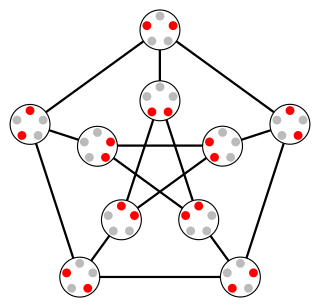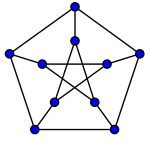In graph theory, a uniquely colorable graph is a k-chromatic graph that has only one possible (proper) k-coloring up to permutation of the colors. Equivalently, there is only one way to partition its vertices into k independent sets and there is no way to partition them into k − 1 independent sets.

In graph theory, the hypercube graphQn is the graph formed from the vertices and edges of an n-dimensional hypercube. For instance, the cube graph Q3 is the graph formed by the 8 vertices and 12 edges of a three-dimensional cube. Qn has 2n vertices, 2n – 1n edges, and is a regular graph with n edges touching each vertex.
In graph theory, Vizing's conjecture concerns a relation between the domination number and the cartesian product of graphs. This conjecture was first stated by Vadim G. Vizing (1968), and states that, if γ(G) denotes the minimum number of vertices in a dominating set for the graph G, then

In graph theory, a graceful labeling of a graph with m edges is a labeling of its vertices with some subset of the integers from 0 to m inclusive, such that no two vertices share a label, and each edge is uniquely identified by the absolute difference between its endpoints, such that this magnitude lies between 1 and m inclusive. A graph which admits a graceful labeling is called a graceful graph.

In combinatorics, an area of mathematics, graph enumeration describes a class of combinatorial enumeration problems in which one must count undirected or directed graphs of certain types, typically as a function of the number of vertices of the graph. These problems may be solved either exactly or asymptotically. The pioneers in this area of mathematics were George Pólya, Arthur Cayley and J. Howard Redfield.
In graph theory, particularly in the theory of hypergraphs, the line graph of a hypergraphH, denoted L(H), is the graph whose vertex set is the set of the hyperedges of H, with two vertices adjacent in L(H) when their corresponding hyperedges have a nonempty intersection in H. In other words, L(H) is the intersection graph of a family of finite sets. It is a generalization of the line graph of a graph.

In graph theory, a discipline within mathematics, the frequency partition of a graph is a partition of its vertices grouped by their degree. For example, the degree sequence of the left-hand graph below is and its frequency partition is 6 = 3 + 2 + 1. This indicates that it has 3 vertices with some degree, 2 vertices with some other degree, and 1 vertex with a third degree. The degree sequence of the bipartite graph in the middle below is and its frequency partition is 9 = 5 + 3 + 1. The degree sequence of the right-hand graph below is and its frequency partition is 7 = 6 + 1.

In graph theory, a division of mathematics, a median graph is an undirected graph in which every three vertices a, b, and c have a unique median: a vertex m(a,b,c) that belongs to shortest paths between each pair of a, b, and c.

In the mathematical field of graph theory, a graph G is said to be hypohamiltonian if G itself does not have a Hamiltonian cycle but every graph formed by removing a single vertex from G is Hamiltonian.
In the mathematical field of graph theory, the Fibonacci cubes or Fibonacci networks are a family of undirected graphs with rich recursive properties derived from its origin in number theory. Mathematically they are similar to the hypercube graphs, but with a Fibonacci number of vertices. Fibonacci cubes were first explicitly defined in Hsu (1993) in the context of interconnection topologies for connecting parallel or distributed systems. They have also been applied in chemical graph theory.

In the mathematical field of graph theory, the odd graphs are a family of symmetric graphs defined from certain set systems. They include and generalize the Petersen graph.

In graph theory, Graph equations are equations in which the unknowns are graphs. One of the central questions of graph theory concerns the notion of isomorphism. We ask: When are two graphs the same? The graphs in question may be expressed differently in terms of graph equations.

In the mathematical field of graph theory, the Clebsch graph is either of two complementary graphs on 16 vertices, a 5-regular graph with 40 edges and a 10-regular graph with 80 edges. The 80-edge graph is the dimension-5 halved cube graph; it was called the Clebsch graph name by Seidel (1968) because of its relation to the configuration of 16 lines on the quartic surface discovered in 1868 by the German mathematician Alfred Clebsch. The 40-edge variant is the dimension-5 folded cube graph; it is also known as the Greenwood–Gleason graph after the work of Robert E. Greenwood and Andrew M. Gleason (1955), who used it to evaluate the Ramsey number R(3,3,3) = 17.
In the mathematical area of graph theory, an undirected graph G is strongly chordal if it is a chordal graph and every cycle of even length in G has an odd chord, i.e., an edge that connects two vertices that are an odd distance (>1) apart from each other in the cycle.

In graph theory, a caterpillar or caterpillar tree is a tree in which all the vertices are within distance 1 of a central path.
In graph theory, a mathematical discipline, coloring refers to an assignment of colours or labels to vertices, edges and faces of a graph. Defective coloring is a variant of proper vertex coloring. In a proper vertex coloring, the vertices are coloured such that no adjacent vertices have the same colour. In defective coloring, on the other hand, vertices are allowed to have neighbours of the same colour to a certain extent.
The Erdős–Gallai theorem is a result in graph theory, a branch of combinatorial mathematics. It provides one of two known approaches to solving the graph realization problem, i.e. it gives a necessary and sufficient condition for a finite sequence of natural numbers to be the degree sequence of a simple graph. A sequence obeying these conditions is called "graphic". The theorem was published in 1960 by Paul Erdős and Tibor Gallai, after whom it is named.
In the mathematical discipline of graph theory, a rainbow matching in an edge-colored graph is a matching in which all the edges have distinct colors.
In the mathematical discipline of graph theory, the 2-factor theorem, discovered by Julius Petersen, is one of the earliest works in graph theory. It can be stated as follows:
Let G be a regular graph whose degree is an even number, 2k. Then the edges of G can be partitioned into k edge-disjoint 2-factors.
In graph theory, a balanced hypergraph is a hypergraph that has several properties analogous to that of a bipartite graph.












